Antigua offers a wide variety of culinary options, from authentic Caribbean and specifically Antiguan dishes, to those with strong European influences. Although many visitors will dine in their all-inclusive resorts where they are likely to find international food served with distinct Caribbean differences, trying local food is an enjoyable part of any holiday, and Antigua has a lot of specialities not to be missed. Discover tempting street food, rustic rum shops, seaside eateries and village restaurants. The food is not excessively spicy, although hot pepper sauce can be found on many restaurant tables.
Take your pick of restaurants and cafés on Antigua, there are literally hundreds catering for both tourists and the local trade: there’s everything from upmarket dining rooms to laid-back beach bars where you can enjoy a casual lunch or drink. Don’t expect a quick turnaround, it’s all about going with the leisurely flow here and remember that a 10 percent service charge is usually added to the bill. Meanwhile, Barbuda restaurants are very limited and, unlike its cosmopolitan neighbour, may have to be booked in advance. Restaurants are often closed out of the tourist season, so call to see if they are open before you go.
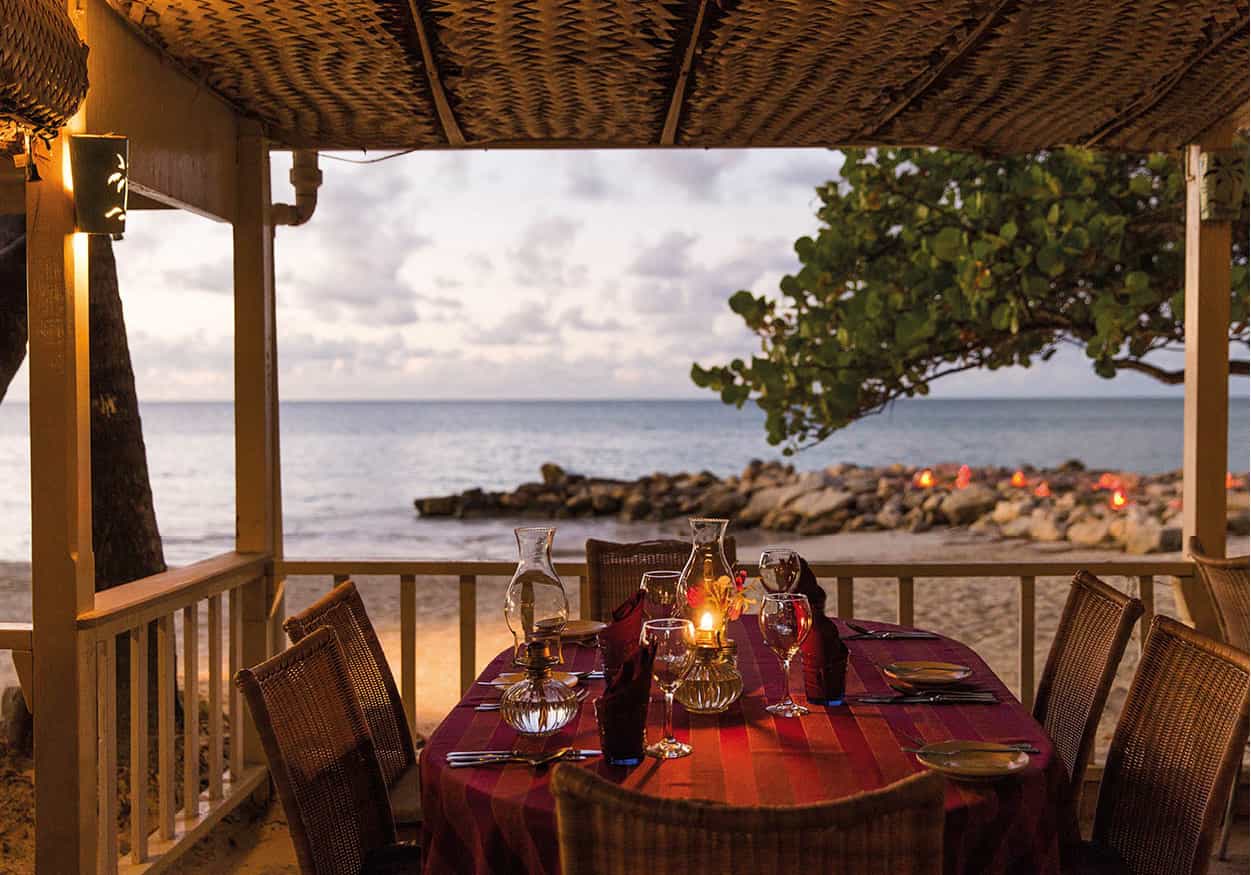
Coconut Grove restaurant, Dickenson Bay
Robert Harding
What to eat
Culinary influences
The earliest settlers to the islands survived on a limited number of indigenous foods including sweet potatoes, black pineapples, plantains, maize, bananas, coconuts and beans. The surrounding ocean yielded a plentiful supply of fish and a myriad of seafood. There were few land animals so meat was not a major part of the local diet.
The Arawak people were the first to introduce organised farming, cultivating the staples that are still so important today, namely maize and sweet potatoes. They also began to trade with neighbouring islands. Finally defeated by the Caribs in the 12th century, there was a gradual introduction of European influences, first with the early Spanish settlers and then with the coming of the British in the mid-17th century, who were responsible for bringing African slaves to their sugar plantations. From Europe the introduction of animals saw the diet supplemented with beef, milk and cheese. The African influence was less influential as the slaves lived mainly on a diet of rice but this would prove to be a substantial part of the menu in the following centuries, right up to the present day.
The 20th and 21st centuries have brought with them an influx of international ethnic foods, and ‘foreign’ Chinese, French, American and Italian restaurants have been springing up across Antigua for years.
Fish and meat
Fish and shellfish are abundant in Antigua, although lobster is usually expensive. There are however, plenty of fresh ones on the menu in Barbuda as they are native to Codrington Lagoon and are an island delicacy. Conch (pronounced konk) is served in salads or as fritters – great, either way. Red snapper, king fish, grouper, swordfish and mahi mahi (dorado), and wahoo, which has a tuna-like taste and texture, are all good. Lobster is usually barbecued and served Creole-style with rice and spices.
Chicken and spare ribs are the most commonly eaten meats and both may be served with a spicy Creole sauce. You can find excellent barbequed chicken on the streets around St. John’s and English Harbour. Jerk meat dishes, originating from Jamaica, are now also popular in Antigua. Meats on the restaurant menu include beef, pork, baked chicken, stewed lamb and goat. Beef and lamb are often imported from the US or Argentina, but goat, pork and chicken are produced locally.
Farming
Although tropical fruit is grown on the island, there is no major crop to replace the sugar monoculture. Sweetcorn, tomatoes, and root vegetables such as sweet potatoes, dasheen and eddo are the main vegetable crops. There is some cattle farming, but herds of sheep and goats are more commonly seen throughout the island, often wandering across the road, and devouring everything they can find. Goat is a staple food for the islanders, but given their numbers, it is surprising that it does not appear on restaurant menus more frequently.
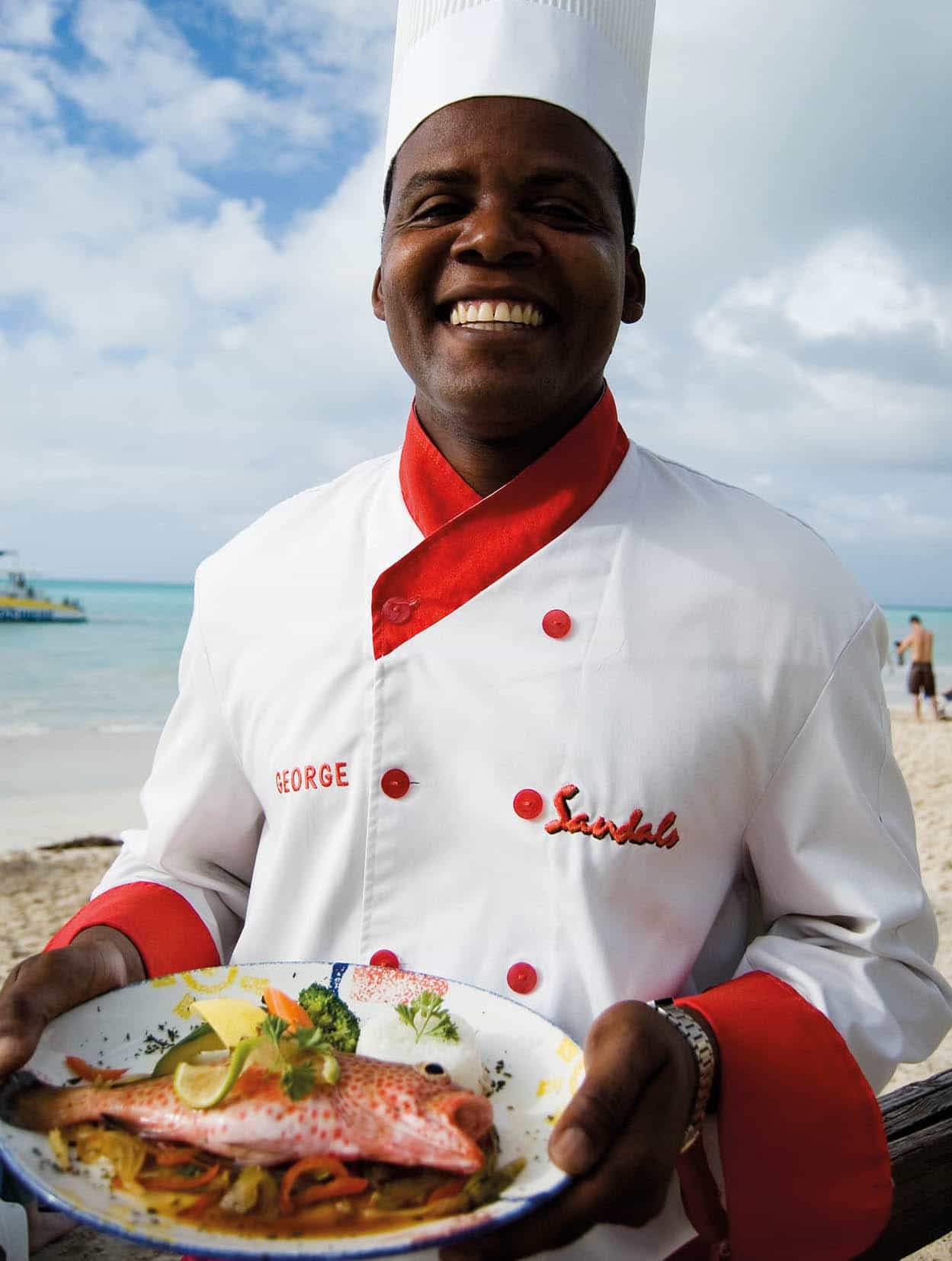
Red snapper often pops up on the menu
Getty Images
Fruit and vegetables
Antigua is one of the driest of the Caribbean islands, which means that some fruit and vegetables have to be imported from Dominica and other islands. But a number of exotic varieties are grown here. Breadfruit, dark green on the outside with yellowish flesh, is full of vitamins, and mainly used as a vegetable – dull when boiled, good when baked or fried. Several varieties of fresh chilli are found in the markets and some are very fiery. The edible roots dasheen and eddo are used like potatoes; while callaloo, a leafy spinach-like vegetable, can be a side dish or made into soup. Pumpkin and okra are widely used, as is sweetcorn, and tomatoes, all of which burst with flavour.
A wonderful selection of fruit is available in season (May–October): mango, watermelon, guava, papaya (paw paw), passion fruit and, of course, bananas and plantains. The latter look like large bananas but have to be cooked – fried, boiled or ground into a flour – and are served as a main course side dish. And don’t forget coconuts, which grow on the tall palms. On the beach, vendors will split and sell them to you with a straw so that you can drink the milk inside. Many of these fruits are also crushed into juice or used to make ice cream, jams and jellies. The indigenous black pineapple – which is not actually black but dark green on the outside when at its most delicious – grows in the southwest of Antigua, and is unique to the island. This small pineapple weighing about 1.2lb (1kg) is extra sweet and it’s a delicacy that should be tried if you see it on a restaurant menu or on sale in a local market. It takes pride of place as the national fruit and sits proudly on the top of the country’s coat of arms.
Soursop
Soursop is a large green fruit with a prickly skin. They can be as much as 8 inches (20cm) long and weigh up to 6lbs (nearly 3kg). Although the fruit may be eaten raw, it is more often made into soft drinks, mousse and ice cream. The drinks tend to be over-sweetened, but the mousse and ice cream are delicious.
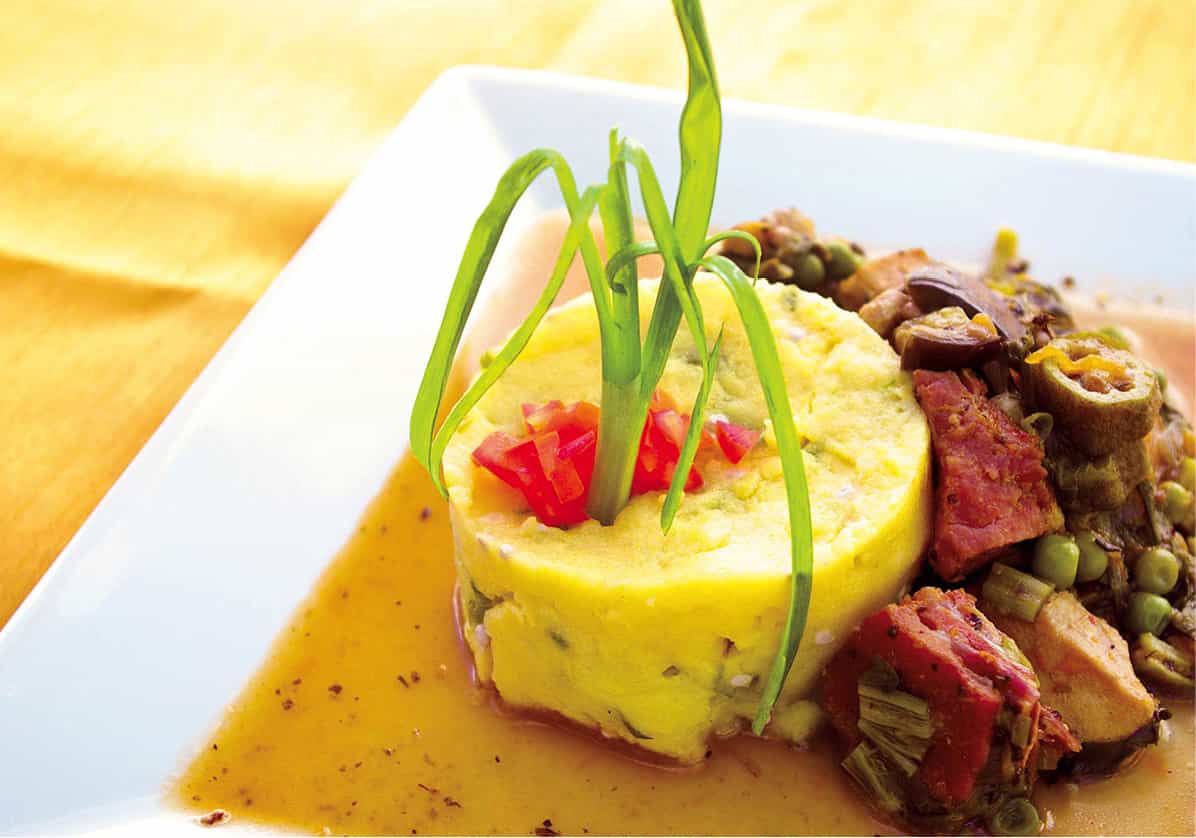
Fungee and pepperpot stew are local specialities
Antigua & Barbuda Tourism Authority
Specialities
Here are some local dishes that regularly pop up on menus and are well worth trying:
Antiguan butter bread – a soft buttery loaf of bread often served with cheese for breakfast.
Bull-foot soup – also known as cow-heel soup, made with the lower extremities of the cow and vegetables. It is really the gelatinous tissue between and around the joints of the feet of the animal.
Coconut soup – worth sampling for the novelty.
Ducana – The huge leaves of the coccoloba tree are used to wrap a mixture of spiced and grated sweet potatoes, coconut and flour; when cooked, the leaf is discarded.
Fungee (also spelled foongee and fungi) – a mixture of cornmeal and okra, similar to Italian polenta, and usually eaten with fish or meat.
Goat water – an unappetizing name belies a hearty stew full of flavour from goat seasoned with hot peppers, cloves and cinnamon.
Johnny cakes – a kind of doughnut, usually served at breakfast with salt fish.
Pepperpot stew – a tasty mixture of beef or pork with okra and pumpkin and sometimes dumplings.
Rice and beans speaks for itself and can be very good.
Roti – patties filled with curried potatoes, chicken or beef.
Salt fish – often served with fungee or in a tomato and onion sauce – a favourite for breakfast.
Sous – pork cooked with lime, onions, peppers and spices.
Desserts
If you can bear to drag yourself away from the amazing array of fresh fruits on offer there are other desserts and pastries that may tempt you. Conventional ice cream and locally-made American-style ice cream are readily available but there is also a small band of devotees creating traditionally made ice cream featuring a range of unusual flavours. Using fruits only when in season, the flavours include soursop, golden apple, coconut and even sweet potato. Drop into Fred’s Belgian Waffles and Ice Cream in Redcfliffe Quay in St John’s and you will see ice cream and sorbets made on site in a multitude of luscious flavours. Other popular desserts include apple pie, plus pineapple and mango pie in season, and jelly – known here as jello.
Neighbourhood bakeries make a range of pastries at reasonable prices, featuring cookies, muffins, cakes and tarts. Local confectionery includes peanut brittle; tambran (tamarind) balls (the original sweet and sour); sugar cake coconut squares; and home-made fudge.
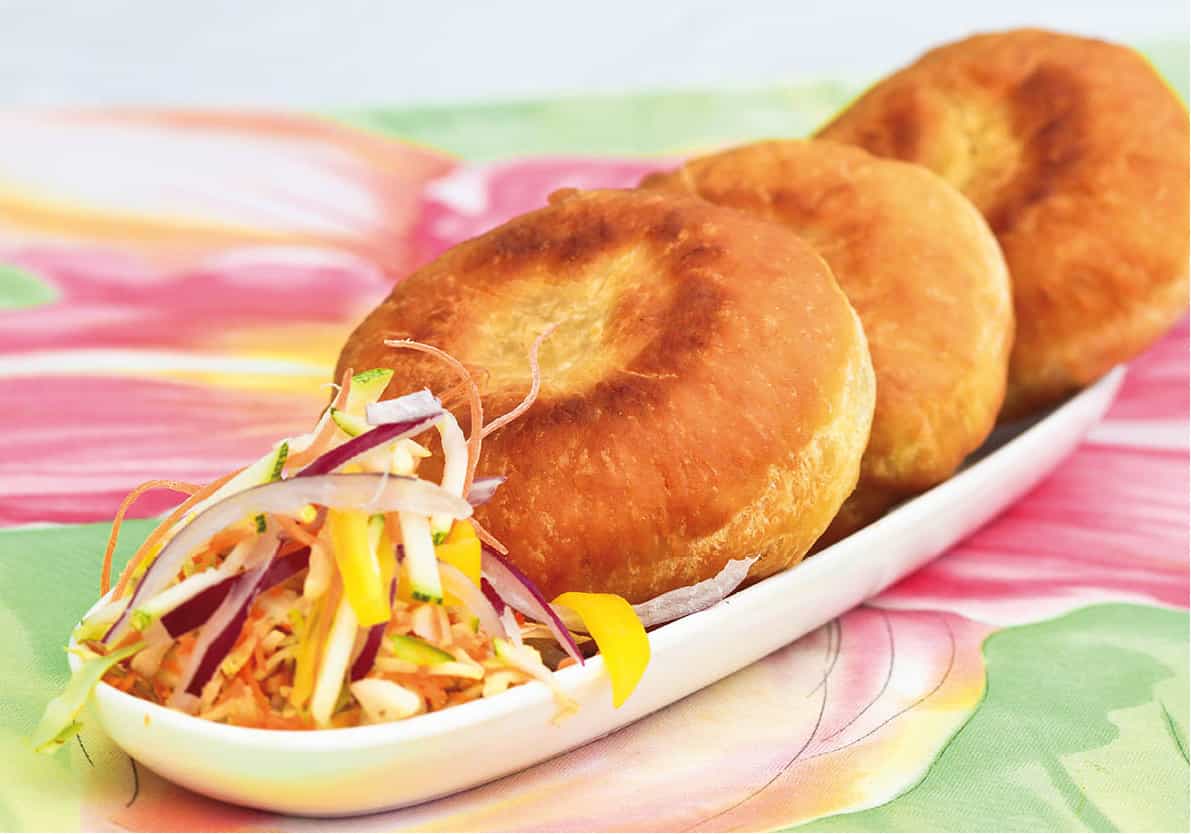
Johnny cakes are a popular choice for breakfast
Antigua & Barbuda Tourism Authority
What to drink
Alcoholic drinks
Think Caribbean, think rum, and Antigua and Barbuda are no exception. The best local option is English Harbour Premium Rum, aged in oak casks for a minimum of five years, making it a great drink and a perfect gift to bring home. The local Cavalier rum is a light golden colour and usually forms the base for numerous mixed drinks. Nutmeg is used a lot, and is good grated onto rum-based drinks. One of the highlights of any trip to the islands is the ubiquitous rum punch made up of lime juice, syrup, rum, water, fruit juices or ginger ale, or as they say in the Caribbean ‘one of sour, two of sweet, three of strong and four of weak’.
Sensational cocktails come in a myriad of flavours. Many of the resort hotels have their own signature cocktails, mixed by slick-handed bartenders. Popular rum-based cocktails include the Mojito, where your rum is blended with mint, lime juice and soda water; the Cuba Libre, a marriage of rum and cola; the strawberry Daiquiri, combining sugar, lime juice, white rum, fresh strawberries, a few drops of strawberry liqueur and lots of ice; and of course, not forgetting the ever-popular Pina Colada, with its rum, pineapple juice and coconut cream.
Beer is widely consumed on the island. The most common brands are the local Wadadli, from the original Arawak name for Antigua, Jamaican Red Stripe, Carib from Trinidad and some American and European brands. Wine is not so readily consumed by the locals, but imported wine is available in all resort hotels and most restaurants. Spirits, aside from rum, are not so popular with locals, but are easily obtainable.
Celebration
Ponche Kuba Cream Liqueur, a thick creamy tan-coloured drink of lightly spiced rum-based cream, is a popular Christmas tipple in Antigua and Barbuda. Served chilled, neat or over ice, it is very sweet and smooth and often strengthened with the addition of brandy or more rum.
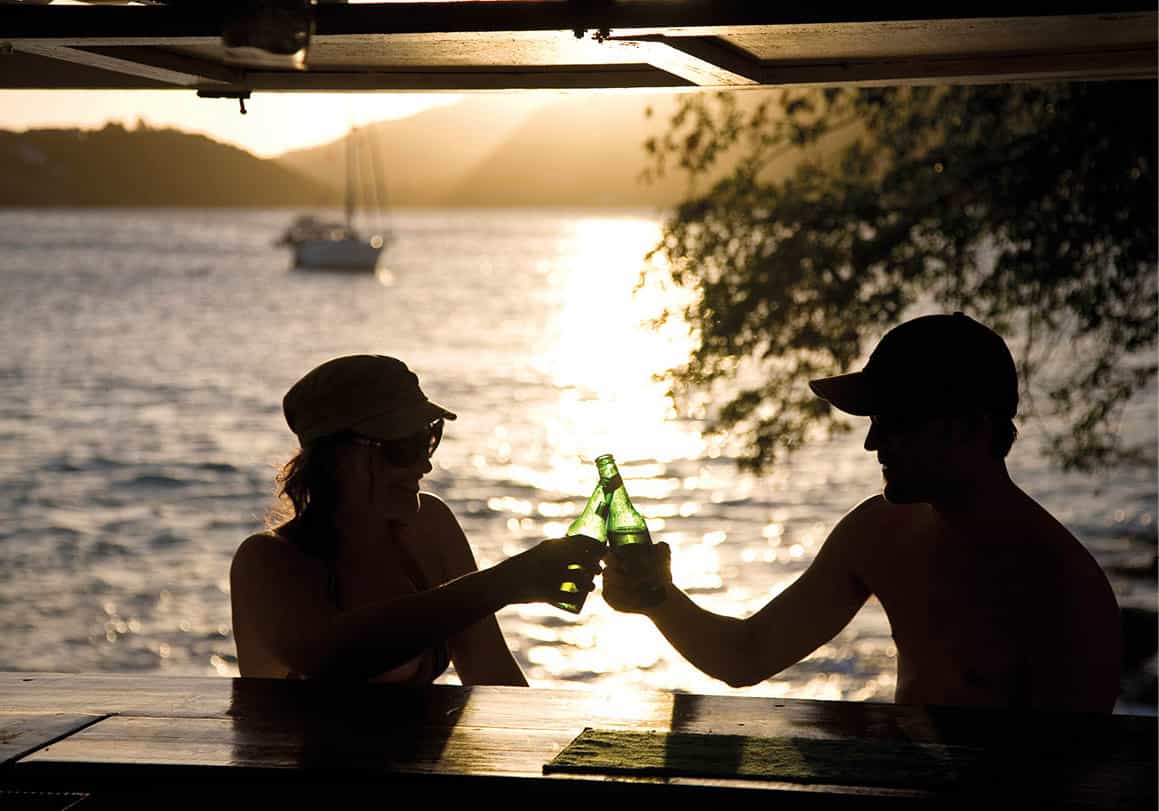
Cheers on the beach
Antigua & Barbuda Tourism Authority
Soft drinks
For quenching your thirst in the heat of the day nothing is more refreshing than the local freshly-squeezed fruit juices. Choose from mango, passion fruit, guava, tamarind, pineapple, coconut, banana, lemongrass and more. Non-alcoholic cocktails are just as inventive as their stronger counterparts and are a highlight of any day. Other popular local drinks on the islands are ginger beer, coconut milk and lemonade.
Local specialities include:
Mauby – based on tree bark and sugar, plus spices and often aniseed.
Peanut Punch – a shake made with peanuts or peanut butter, milk and sugar.
Seamoss – a type of seaweed, which is dried, then boiled and blended with milk, ice, and sweeteners such as cinnamon, sugar, vanilla, and/or nutmeg.
Sorrel – made with the bright red flowers of the hibiscus plant, which are boiled and then strained, cooled, and sweetened.
Soursop Juice – drink made from this local fruit.
Ting – a home-grown, sparkling grapefruit drink.
Tea, although available, is not overly popular. Coffee is the hot drink of choice. En route to Falmouth, a right turn down an unpaved track leads to the Carib Coffee Bean Company, which has been operating here since 1997. Estate-grown Arabica coffee beans are imported from the Caribbean Basin and parts of Latin and Central America and freshly roasted daily. This is the only such operation on the island and the aroma from the roasting beans lets you know that you are buying the freshest coffee available. Choose from their wide selection of coffee blends including the imaginatively named Hurricane Brew, Dark and Stormy, One Luv, Caribbean Dream and Tropical Morning Blend. Experience the process on their Open Roast Days (Nov–Apr Wed; www.caribbeancoffeeroasters.com).